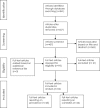Personal stigma in schizophrenia spectrum disorders: a systematic review of prevalence rates, correlates, impact and interventions
- PMID: 23737425
- PMCID: PMC3683268
- DOI: 10.1002/wps.20040
Personal stigma in schizophrenia spectrum disorders: a systematic review of prevalence rates, correlates, impact and interventions
Abstract
A systematic electronic PubMed, Medline and Web of Science database search was conducted regarding the prevalence, correlates, and effects of personal stigma (i.e., perceived and experienced stigmatization and self-stigma) in patients with schizophrenia spectrum disorders. Of 54 studies (n=5,871), published from 1994 to 2011, 23 (42.6%) reported on prevalence rates, and 44 (81.5%) reported on correlates and/or consequences of perceived or experienced stigmatization or self-stigma. Only two specific personal stigma intervention studies were found. On average, 64.5% (range: 45.0-80.0%) of patients perceived stigma, 55.9% (range: 22.5-96.0%) actually experienced stigma, and 49.2% (range: 27.9-77.0%) reported alienation (shame) as the most common aspect of self-stigma. While socio-demographic variables were only marginally associated with stigma, psychosocial variables, especially lower quality of life, showed overall significant correlations, and illness-related factors showed heterogeneous associations, except for social anxiety that was unequivocally associated with personal stigma. The prevalence and impact of personal stigma on individual outcomes among schizophrenia spectrum disorder patients are well characterized, yet measures and methods differ significantly. By contrast, research regarding the evolution of personal stigma through the illness course and, particularly, specific intervention studies, which should be conducted utilizing standardized methods and outcomes, are sorely lacking.
Copyright © 2013 World Psychiatric Association.
References
-
- Angermeyer MC, Matschinger H. The stigma of mental illness in Germany: a trend analysis. Int J Soc Psychiatry. 2005;51:276–84. - PubMed
-
- Corrigan PW, Penn DL. Lessons from social psychology on discrediting psychiatric stigma. Am Psychol. 1999;54:765–76. - PubMed
-
- Corrigan PW, Lurie BD, Goldman HH, et al. How adolescents perceive the stigma of mental illness and alcohol abuse. Psychiatr Serv. 2005;56:544–50. - PubMed
-
- Penn DL, Kohlmaier JR, Corrigan PW. Interpersonal factors contributing to the stigma of schizophrenia: social skills, perceived attractiveness, and symptoms. Schizophr Res. 2000;45:37–45. - PubMed
Grants and funding
LinkOut - more resources
Full Text Sources
Other Literature Sources


